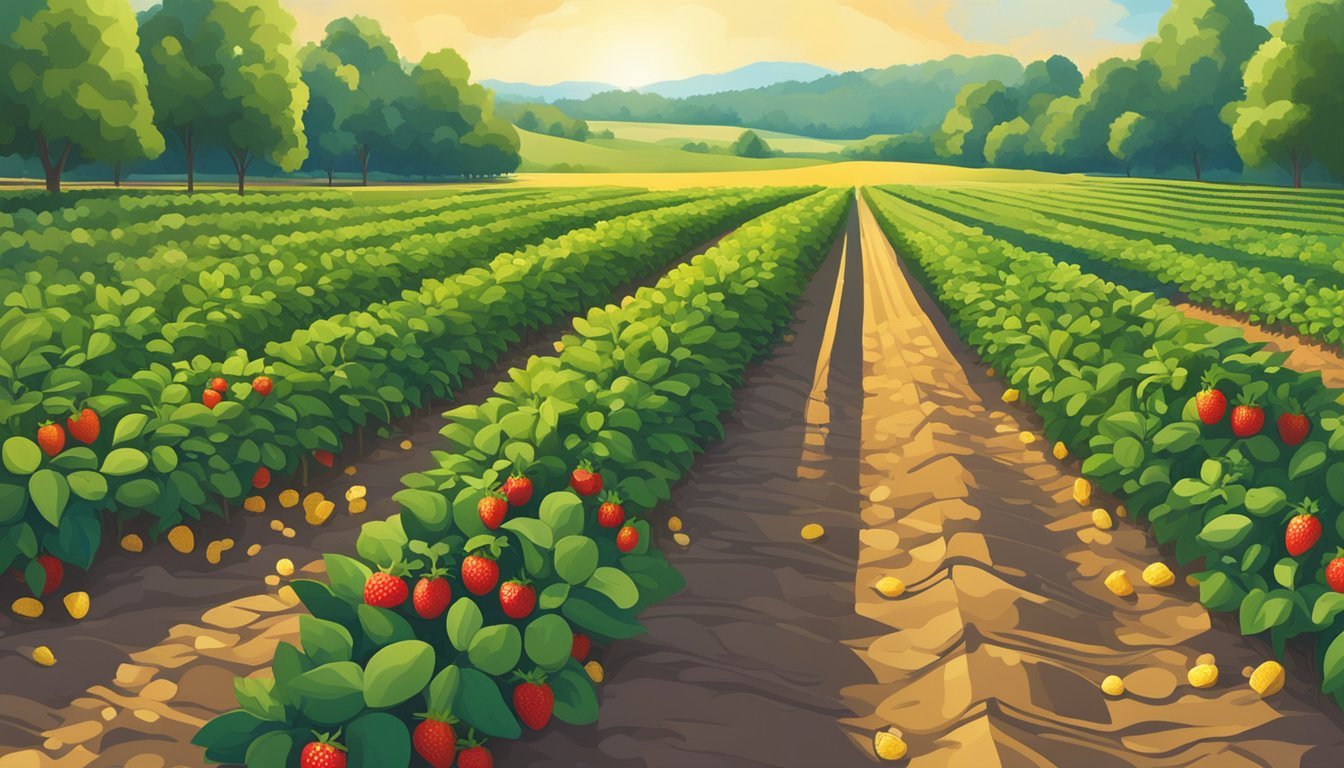North Carolina Seasonal Fruit & Vegetables in June
Your Fresh Produce Guide
This Article is Part of our North Carolina Seasonal Fruit & Veg Calendar
In North Carolina, June marks a transitional period from the spring harvest into the bounty of summer, with a variety of fruits and vegetables reaching their peak season. Farmers' markets and roadside stands begin to overflow with fresh produce as the warmer weather ushers in a new wave of crops. During this time, consumers have the opportunity to enjoy the rich flavors and nutritional benefits of locally sourced items, greatly increasing from what is available during the preceding months.
Freshness dictates the flavor and nutritional value of produce, and June offers an abundance of choices. Stone fruits such as peaches burst into season, their juicy flesh a hallmark of summer sweetness, while blueberries (how long do blueberries last?), brimming with antioxidants, transition from May into their final weeks. Vegetables like cucumbers (how long do cucumbers last?) and summer squash make their debut, offering crisp textures and versatility in summer dishes. Meanwhile, year-round staples such as carrots and a variety of greens remain readily available, their continuity ensuring that balanced diets are easily maintained.
For those keen on supporting local agriculture and indulging in the freshest produce, June in North Carolina is a prime month. It's a time when the state's rich soil and diverse climate zones converge to yield an impressive harvest, one that is eagerly anticipated by chefs and home cooks alike. Whether incorporating these fresh picks into recipes or enjoying them raw, the seasonal offerings provide exceptional taste and quality during this month.
Seasonal Changes and Its Impact on Produce
As North Carolina transitions from May's late spring into the heart of June's summer, local crops experience significant changes due to the evolving seasonal climate, directly affecting their availability and quality at farmers' markets.
Transition from Spring to Summer
During the transition from spring to summer, North Carolina’s climate begins to warm considerably. By June, the state bids farewell to the cool and mild temperatures of April and May, welcoming the warmer days which are ideal for a variety of fruits and vegetables to thrive. This seasonal shift marks the end of availability for some spring crops and the peak beginning for many summer fruits and vegetables.
Late Spring Crops (May to early June): The tail end of asparagus and strawberry season.
Summer Crops Starting in June: Include peaches, cucumbers, and blueberries.
This period demands that farmers adapt their planting schedules and harvesting techniques to ensure a seamless transition that maximizes the yield and freshness of their produce for the local markets.
Effects of Seasonal Weather
The weather during June in North Carolina brings a combination of increased sunlight and sporadic rainfall that contributes to the growth of summer crops. The warmth and longer daylight hours are critical for photosynthesis, leading to more robust fruiting and larger harvests.
Sunlight: Longer days increase photosynthesis, which is essential for the growth of summer crops like peaches and cucumbers.
Rainfall: Adequate rain is necessary for plant health, but excessive moisture can promote fungal diseases or damage produce.
Farmers rely on their expertise to manage these conditions, using varied agricultural practices to protect their crops from weather extremes. The result is a bountiful presence of fresh produce at farmers' markets, ripe and at peak flavor during this time of the year.
North Carolina's Agricultural Calendar
June marks a vibrant period for North Carolina's agriculture, with an array of fruits and vegetables being harvested. This is a prime month for locals and visitors to explore farmers markets for the freshest produce.
June's Harvest
Fruits:
Blueberries: Full season starts, offering fresh, plump berries.
Peaches: Begin to ripen, bringing sweet and juicy flavors to markets.
Vegetables:
Sweet Corn: Prime harvesting begins, delivering fresh, sweet ears of corn.
Note: Availability might vary by region within the state.
Upcoming Harvests: July and Beyond
Looking forward to July, the bounty continues with a variety of produce reaching their peak harvest times.
Fruits:
Peaches: The harvest continues through September.
Blueberries: Remain available until the end of their season in July.
Vegetables:
As July approaches, anticipate staples like Okra and Cucumbers, with their freshness lasting through the summer months.
The information presented reflects typical harvesting periods and can be subject to changes based on weather and other local conditions.
Fresh Produce Availability
In June, consumers have the opportunity to enjoy a variety of fresh, locally grown fruits and vegetables in North Carolina. These items are not only at their peak of flavor but are also readily available in grocery stores and farmers' markets.
Fruits to Expect
Blueberries: Beginning in May and extending through July, blueberries are widely available.
Peaches: The peach season starts in June and lasts until September, making it the perfect time to indulge in this juicy fruit.
Watermelon: Though it peaks later in summer, watermelon begins to become available in June.
Vegetables in Season
Sweet Corn: One can start to find the freshest sweet corn in June, a staple for summer barbecues.
Cucumbers: June marks the start of the cucumber season, which continues until mid-August.
Kale: While kale is available year-round, its availability is robust in June, offering a fresh, nutritious option.
Carrots: Locally grown carrots are fresh and in season, adding crunch to any dish.
Nutritional Benefits of Seasonal Produce
Eating fruits and vegetables that are in season offers significant nutritional advantages. In June, North Carolina's seasonal produce provides an abundance of vitamins and minerals due to the crops being harvested at their peak of ripeness.
Peaches: These juicy fruits are high in vitamins A and C and are a good source of dietary fiber, which aids in digestive health.
Blueberries: Rich in antioxidants, they also contribute vitamins C and K and dietary fiber, supporting heart health and offering cancer-preventive properties.
Cucumbers: Containing vitamin K, B vitamins, potassium, and water, cucumbers promote hydration and support cardiovascular health.
Watermelon: Offers hydration due to its high water content, while also providing vitamins A, C, and B6, and antioxidants such as lycopene.
Consumption of fresh produce during their prime season ensures a higher density of nutrients. Produce that is consumed close to its harvest date retains more of its natural flavor and texture, enhancing its overall appeal and increasing the likelihood of consumption.
In-season fruits and vegetables also typically require less transportation and storage, which can lead to a decrease in nutrient degradation over time. Thus, individuals consuming these foods are more likely to receive a more potent nutritional profile compared to out-of-season or stored produce.
Residents and consumers in North Carolina have the advantage of enjoying this flavorful and nutritionally superior produce during the month of June.
Supporting Local Farmers
Residents of North Carolina have a significant opportunity in June to support local farmers by purchasing locally grown produce. This support strengthens the community's economy and fosters a connection between consumers and the sources of their food.
Benefits of Buying Local
Buying local has numerous advantages that extend beyond the immediate gratification of consuming fresh produce. Local economic stimulus is one of the primary benefits, as money spent on locally grown fruits and vegetables circulates within the state, bolstering the local economy. Consumers also benefit from increased nutritional value, as fruits and vegetables are often picked at their peak ripeness, containing more nutrients than those that have traveled long distances.
Furthermore, purchasing from local farmers aids in sustainability efforts, reducing the carbon footprint associated with transportation. When North Carolinians choose locally sourced goods, they support a sustainable agriculture system that has a lesser environmental impact.
Where to Find Local Produce
Local produce in North Carolina can be found in a variety of locations, each offering a unique experience:
Farmers Markets: Farmers markets are the go-to destinations for the freshest seasonal produce. They provide a place where customers can interact directly with the farmers and learn more about how their food is grown.
Grocery Stores: Many grocery stores in the state have sections dedicated to locally sourced produce. Shoppers should look for signage that indicates local options.
Community Supported Agriculture (CSA): Joining a CSA program ensures a regular supply of fresh produce while directly supporting a farmer's livelihood.
Social Media Platforms: North Carolina residents can follow local farmers on platforms like Facebook, Twitter, and Pinterest for updates on produce availability and market locations.
By exploring these outlets, the community can find an abundance of fresh, seasonal produce such as cucumbers, peaches, and blueberries while supporting the local farming industry in North Carolina.
Preparing and Storing Seasonal Fruits and Vegetables
June brings a bounty of fresh fruits and vegetables to North Carolina, each requiring specific handling to maintain freshness and nutritional value. Here, you'll learn the best methods for preparing and storing June's seasonal produce, ensuring your ingredients remain as delicious and nutritious as when picked.
Best Practices for Freshness
Cantaloupe (how long does cantaloupe last?): A ripe cantaloupe should be heavy for its size with a sweet fragrance. Store whole cantaloupes at room temperature to soften and become juicier. Once cut, wrap it tightly or place it in an airtight container and refrigerate.
Sweet Corn: For the freshest sweet corn, eat it the same day it is purchased or picked. If that's not possible, husk it, wrap it in a damp paper towel, and place it in a plastic bag in the crisper drawer of your refrigerator to extend its freshness for a couple of days.
General Tips:
Wash all fruits and vegetables under running water before eating or storing, and dry thoroughly with a clean cloth or paper towel.
Storage: Most fresh produce should be stored in a refrigerator set at 40°F or below to slow down decay and maintain nutritional quality. However, refrigeration isn't advisable for all produce, as some, like tomatoes, can lose flavor and texture when refrigerated.
Keep your fruits and vegetables separate from raw meats to prevent cross-contamination.
Recipe Ideas for June Produce
Extract maximum enjoyment from June's selection by incorporating them into meals. Toss sweet corn kernels into salads or soups, or grill for a smoky addition to salsas. Cantaloupe can be cut into cubes for a refreshing summer salad mixed with other seasonal fruits or prosciutto for a savory twist.
Cantaloupe Smoothie: Blend with yogurt and a drizzle of honey for a nutritious breakfast or snack.
Corn Fritters: Combine fresh corn kernels, flour, eggs, and herbs, then pan-fry for a crispy, savory treat.
The start of the summer season is an excellent opportunity to enjoy the flavors of North Carolina's seasonal produce. Proper handling and storage coupled with creative recipes can turn these ingredients into memorable meals.







